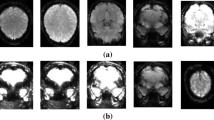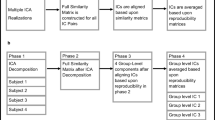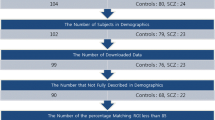Abstract
Functional magnetic resonance imaging (fMRI) is a fairly new technique that has the potential to characterize and classify brain disorders such as schizophrenia. It has the possibility of playing a crucial role in designing objective prognostic/diagnostic tools, but also presents numerous challenges to analysis and interpretation. Classification provides results for individual subjects, rather than results related to group differences. This is a more complicated endeavor that must be approached more carefully and efficient methods should be developed to draw generalized and valid conclusions out of high dimensional data with a limited number of subjects, especially for heterogeneous disorders whose pathophysiology is unknown. Numerous research efforts have been reported in the field using fMRI activation of schizophrenia patients and healthy controls. However, the results are usually not generalizable to larger data sets and require careful definition of the techniques used both in designing algorithms and reporting prediction accuracies. In this review paper, we survey a number of previous reports and also identify possible biases (cross-validation, class size, e.g.) in class comparison/prediction problems. Some suggestions to improve the effectiveness of the presentation of the prediction accuracy results are provided. We also present our own results using a projection pursuit algorithm followed by an application of independent component analysis proposed in an earlier study. We classify schizophrenia versus healthy controls using fMRI data of 155 subjects from two sites obtained during three different tasks. The results are compared in order to investigate the effectiveness of each task and differences between patients with schizophrenia and healthy controls are investigated.








Similar content being viewed by others
References
Baddeley, A. (1992). Working memory. Science, 255(5044), 556–559.
Bellman, R. (1961). Adaptive control processes - A guided tour (pp. 255). Princeton: Princeton University Press.
Braff, D. L. (1993). Information processing and attention dysfunctions in schizophrenia. Schizophrenia Bulletin, 19, 233–259.
Calhoun, V. D., Adali, T., Pearlson, G. D., & Pekar, J. (2001a). Group ica of functional MRI data: Separability, stationarity, and inference. In ICA2001. San Diego, CA.
Calhoun, V. D., Adali, T., Pearlson, G. D., & Pekar, J. J. (2001b). A method for making group inferences from functional mri data using independent component analysis. Human Brain Mapping, 14, 140–151.
Calhoun, V. D., Adali, T., Pearlson, G. D., & Pekar, J. J. (2001c). Spatial and temporal independent component analysis of functional MRI data containing a pair of task-related waveforms. Human Brain Mapping, 13, 43–53.
Calhoun, V. D., Kiehl, K. A., Liddle, P. F., & Pearlson, G. D. (2004). Aberrant localization of synchronous hemodynamic activity in auditory cortex reliably characterizes schizophrenia. Biological Psychiatry, 55, 842–849.
Calhoun, V. D., Maciejewski, P. K., Pearlson, G. D., Pearlson, G. D., & Kiehl, K. A. (2008). Temporal lobe and default hemodynamic brain modes discriminate between schizophrenia and bipolar disorder. Human Brain Mapping (in press).
Casey, B., Cohen, J., & O’Craven, K. (1998). Reproducability of fMRI results across four institutions using a spatial working memory task. NeuroImage, 8(3), 249–261.
Demirci, O., & Calhoun, V. D. (2007). Detection of schizophrenia using fMRI data via projection pursuit. In IEEE international workshop on machine learning for signal processing. Thessaloniki, Greece.
Demirci, O., Clark, V., & Calhoun, V. D. (2008). A projection pursuit algorithm to classify individuals using fMRI data: Application to schizophrenia. NeuroImage, 39, 1774–1782.
Demirci, O., Tyo, J. S., & Ritchie, E. A. (2007). Spatial and spatiotemporal projection pursuit techniques to predict the extratropical transition of tropical cyclones. IEEE Transactions on Geoscience and Remote Sensing, 45, 418–425.
Fan, Y., Rao, H., Hurt, H., Gianetta, J., Korczykowski, M., Shera, D., et al. (2007). Multivariate examination of brain abnormality using both structural and functional MRI. NeuroImage, 36, 1189–1199.
First, M. B., Spitzer, R. L., Gibbon, M., & Williams, J. B. W. (1995). Structured clinical interview for Dsm-Iv axis I disorders—patient edition (Scid-I/P, Version 2.0). New York: Biometrics Research Department, New York State Psychiatric Institute.
Ford, J., Farid, H., Makedon, F., Flashman, L., McAllister, T., Megalooikonomou, V., et al. (2003). Patient classification of fMRI activation maps. In Proc. of the 6th annual international conference on medical image computing and computer assisted intervention (MICCAI’03).
Ford, J., Shen, L., Makedon, F., Flashman, L. A., & Saykin, A. J. (2002). A combined structural-functional classification of schizophrenia using hippocampal volume plus fMRI activation. In Second joint EMBS/BMES conference. Houston, TX.
Freire, L., Roche, A., & Mangin, J. F. (2002). What is the best similarity measure for motion correction in fMRI time series? IEEE Transactions on Medical Imaging, 21, 470–484.
Friedman, L., Glover, G. H., & FBIRN (2006). Reducing interscanner variability of activation in a multicenter fMRI study: Controlling for signal-to-fluctuation-noise-ratio (sfnr) differences. NeuroImage, 33, 471–481.
Friston, K., Ashburner, J., Frith, C. D., Poline, J. P., Heather, J. D., & Frackowiak, R. S. (1995). Spatial registration and normalization of images. Human Brain Mapping, 2, 165–189.
Garrity, A. G., Pearlson, G. D., McKiernan, K., Lloyd, D., Kiehl, K. A., & Calhoun, V. D. (2007). Aberrant “default mode” functional connectivity in schizophrenia. American Journal of Psychiatry, 164(3), 450–457.
Georgopoulos, A. P., Karageorgiou, E., Leuthold, A., Lewis, S. M., Lynch, J., Alonso, A. A., et al. (2007). Synchronous neural interactions assessed by magnetoencephalography: A functional biomarker for brain disorders. Journal of Neural Engineering, 4, 349–355.
Gerig, G., Styner, M., Shenton, M. E., & Lieberman, J. A. (2001). Shape versus size: Improved understanding of the morphology of brain structures. In Proc. MICCAI 2001. Lecture Notes in Computer Science 2208 (pp. 24–32).
GIFT (2008). Group ICA of fMRI Toolbox (GIFT). http://icatb.sourceforge.net/.
Golland, P., Grimson, W. E. L., Shenton, M. E., & Kikinis, R. (2000). Small sample size learning for shape analysis of anatomical structures. In Proceedings of MICCAI. Third international conference on medical robotics, imaging and computer assisted intervention, LNCS (Vol. 1935, pp. 72–82).
Hyvarinen, A., Karhunen, Y., & Oja, E. (2001). Independent component analysis. New York: Wiley-Interscience (May 18)
Jimenez, L. O., & Landgrebe, D. A. (1998). Supervised classification in high-dimensional space: Geometrical, statistical, and asymptotical properties of multivariate data. IEEE Transactions on Systems, Man, and Cybernetics-Part C, 28, 39–54.
Jimenez, L. O., & Landgrebe, D. A. (1999). Hyperspectral data analysis and supervised feature reduction via projection pursuit. IEEE Transactions on Geoscience and Remote Sensing, 37, 2653–2667.
Job, D. E., Whalley, H. C., McIntosh, A. M., Owens, D. G., Johnstone, E. C., & Lawrie, S. M. (2006). Grey matter changes can improve the prediction of schizophrenia in subjects at high risk. BioMed Central, 4, 29.
Kiehl, K. A., Liddle, P. F. (2001). An event-related functional magnetic resonance imaging study of an auditory oddball task in schizophrenia. Schizophrenia Research, 48, 159–171.
Kiehl, K. A., Stevens, M. C., Celone, K., Kurtz, M., & Krystal, J. H. (2005). Abnormal hemodynamics in schizophrenia during an auditory oddball task. Biological Psychiatry, 57, 1029–1040.
Kontos, D., Megalooikonomou, V., Ghubade, N., & Faloutsos, C. (2004). Detecting discriminative functional MRI activation patterns using space filling curves. In Proc. of the 25th annual international conference of the IEEE engineering in medicine and bilogy society (EMBC). Cancun, Mexico.
Kwong, K. K., Belliveau, J. W., Chesler, D. A., Goldberg, I. E., Weisskoff, R. M., Poncelet, B. P., et al. (1992). Dynamic magnetic resonance imaging of human brain activity during primary sensory stimulation. Proceedings of the National Academy of Sciences, 89, 5675–5679.
McCarley, R. W., Shenton, M. E., O’Donnell, B. F., Faux, S. F., Kikinis, R., Nestor, P. G., et al. (1993). Auditory p300 abnormalities and left posterior superior temporal gyrus volume reduction in schizophrenia. Archives of General Psychiatry, 50, 190–197.
McGhie, A., & Chapman, J. (1961). Disorders of attention and perception in early schizophrenia. British Journal of Medical Psychology, 34, 103–116.
McKeown, M. J., Makeig, S., Brown, G. G., Jung, T. P., Kindermann, S. S., Bell, A. J., et al. (1998). Analysis of fmri data by blind separation into independent spatial components. Human Brain Mapping, 6, 160–188.
Nakamura, K., Kawasaki, Y., Suzuki, M., Hagino, H., Kurokawa, K., Takahashi, T., et al. (2004). Multiple structural brain measures obtained by three-dimensional magnetic resonance imaging to distinguish between schizophrenia patients and normal subjects. American Journal of Psychiatry, 158, 1809–1817.
Ogawa, S., Lee, T. M., Kay, A. R., & Tank, D. W. (1990). Brain magnetic resonance imaging with contrast dependent on blood oxygenation. Proceedings of the National Academy of Sciences, 87, 9868–9872.
Pardo, P. J., Georgopoulos, A. P., Kenny, J. T., Stuve, T. A., Findling, R. L., & Schulz, S. C. (2006). Classification of adolescent psychotic disorders using linear discriminant analysis. Schizophrenia Research, 87, 297–306.
Pokrajac, D., Megalooikonomou, V., Lazarevic, A., Kontos, D., & Obradovic, Z. (2005). Applying spatial distribution analysis techniques to classification of 3D medical images. Artificial Intelligence in Medicine, 33, 261–280.
Robert, P., & Escoufier, Y. (1976). A unifying tool for linear multivariate statistical methods: The RV-coefficient. Applied Statistics, 25, 257–265.
Shankardass, A., Nicolson, R., & Fawcett, A. (2001). A combined structural–functional classification of schizophrenia using hippocampal volume plus fMRI activation. In 5th BDA international conference. University of York, UK.
Shen, L., Ford, J., Makedon, F., & Saykin, A. (2004). A surface-based approach for classification of 3d neuroanatomic structures. Intelligent Data Analysis, An International Journal, 8(6), 519–542.
Shinkareva, S. V., Ombao, H. C., Sutton, B. P., Mohanty, A., & Miller, G. A. (2006). Classification of functional brain images with a spatio-temporal dissimilarity map. NeuroImage, 33, 63–71.
Simon, R. (2004). When is a genomic classifier ready for prime time? Nature Clinical Practice, 1, 4–5.
Simon, R., Radmacher, M. D., Dobbin, K., & McShane, L. M. (2003). Pitfalls in the use of DNA Microarray Data for Diagnostic and Prognostic Classification. Journal of the National Cancer Institute, 95(1), 14–18.
SPM5 (2008). Statistical parametric mapping (SPM). http://www.fil.ion.ucl.ac.uk/spm/.
Symond, M. B., Harris, A. W. F., Gordon, E., & Williams, L. M. (2005). Gamma synchrony in first-episode schizophrenia: A disorder of temporal connectivity? American Journal of Psychiatry, 162, 459–465.
Tecchio, F., Benassic, F., Zappasodia, F., Gialloretid, L. E., Palermoe, M., Serif, S., et al. (2003). Auditory sensory processing in autism: A magnetoencephalographic study. Biological Psychiatry, 54, 647–654.
Tegeler, C., Strother, S., Anderson, J., & Kim, S. (1999). Reproducability of BOLD-based functional MRI obtained at 4T. Human Brain Mapping, 7(4), 267–283.
Wang, Q., Kontos, D., Li, G., & Megalooikonomou, V. (2004). Application of time series techniques to data mining and analysis of spatial patterns in 3D images. In Proc. of the 2004 IEEE international conference on acoustics, speech, and signal processing (ICASSP 2004).
Watersa, F. A. V., Badcockb, J. C., Mayberya, M. T., & Michiea, P. T. (2003). Inhibition in schizophrenia: Association with auditory hallucinations. Schizophrenia Research, 62, 275–280.
Wood, I., Visscher, P., & Mengersen, K. (2007). Classification based upon gene expression data: Bias and precision of error rates. Bioinformatics, 23, 1363–1370.
Acknowledgements
The data collection was funded by the Department of Energy, grant DE-FG02-99ER62764. The authors would like to thank the MIND Research Network staff for their efforts during the data collection processes. This work was funded by the National Institutes of Health, under grants 1 R01 EB 000840 and 1 R01 EB 005846.
Author information
Authors and Affiliations
Corresponding author
Appendix A
Appendix A
An observation matrix, X, including n subjects each represented with m voxels,
Two different covariance matrices can be defined, and two different eigendecompositions are possible,
where
and
Nonzero eigenvalues of covariance matrices X X T, { λ 1, ...λ n }, and X T X, {l 1, ...l n }, are the same and eigenvectors corresponding to the higher dimensional covariance matrix, {q 1, ...q n }, can be derived from the eigenvectors of the smaller one, {p 1, ...p n }. This useful information can be used in cases where the number of data points is a lot higher than the number of observations. Here we present a proof of this fact.
Using Eq. 4 as a beginning point,
can be obtained. Equation 11 can be further used,
and a relationship between P and Q can be reached. Using Eq. 4 again,
can be obtained. The same equation is valid for every column separately and can be expressed as,
Rights and permissions
About this article
Cite this article
Demirci, O., Clark, V.P., Magnotta, V.A. et al. A Review of Challenges in the Use of fMRI for Disease Classification / Characterization and A Projection Pursuit Application from A Multi-site fMRI Schizophrenia Study. Brain Imaging and Behavior 2, 207–226 (2008). https://doi.org/10.1007/s11682-008-9028-1
Received:
Accepted:
Published:
Issue Date:
DOI: https://doi.org/10.1007/s11682-008-9028-1




